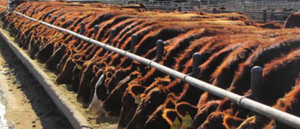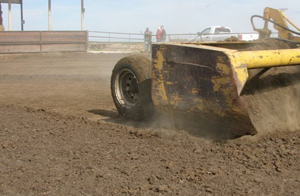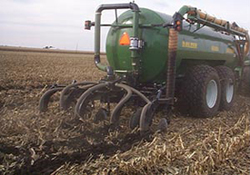Reducing Ammonia Emissions from Animal Production Systems
Animal Production
In animal production systems, ammonia emissions most often originate from urea-nitrogen in
urine or feces. Most of that nitrogen enters the animal as feed protein, which producers want
to convert to meat or milk. The best means of reducing ammonia emissions is to maximize the
amount of protein utilized by the animal, thereby capturing the maximum value from the feed
input and minimizing negative environmental consequences.
Even when rations are balanced to provide the optimal levels of crude protein in the most
available forms, some portion (usually greater than 80% in cattle) of nitrogen fed will be
passed through the animal. Some general management strategies for minimizing ammonia
emissions from animal production systems include:
- Feed Management
 Manage protein intake and balance rations to maximize conversion of protein
into meat or milk. This includes phase feeding by stage of growth or production
and utilizing nutritionists to develop balanced rations. When possible, rations
should be formulated based on “as-delivered” feed ingredient analyses and protein
analyses should be based on “metabolizable protein” rather than “crude protein”.
Manage protein intake and balance rations to maximize conversion of protein
into meat or milk. This includes phase feeding by stage of growth or production
and utilizing nutritionists to develop balanced rations. When possible, rations
should be formulated based on “as-delivered” feed ingredient analyses and protein
analyses should be based on “metabolizable protein” rather than “crude protein”.- Utilize technologies to improve the digestibility and/or conversion of protein to
meat or milk.
- Consult nutritionists and have feedstocks tested for protein and energy when
utilizing non-traditional or alternative feedstocks in diet rations. Feeding dietary
protein in excess of animal needs leads to increases in ammonia emissions.
- Animal Housing
 Maintain dry, well drained open lots with properly constructed mounds for
animals to rest on. Dry pens produce less ammonia than wet pens. Sprinkling
pens for dust control may also reduce ammonia emissions when ammonia is
leached into the pen surface material.
Maintain dry, well drained open lots with properly constructed mounds for
animals to rest on. Dry pens produce less ammonia than wet pens. Sprinkling
pens for dust control may also reduce ammonia emissions when ammonia is
leached into the pen surface material.- Maintaining clean pen surfaces. Clean pen surfaces are characterized by lower
emissions of dust, odor, and ammonia.
- In enclosed housing, maintain good bedding conditions and minimize the floor
area that is wetted or covered in manure. Separating manure and urine through
use of slatted floors, drained sand bedding, or textured surfaces that channel away
urine will reduce emissions.
- Manure Management
- For flush systems, ammonia emissions generally decrease as flush frequency
increases.
- For liquid manure management systems, ammonia emissions are generally lower
when nitrogen levels in effluent and treatment structures are maintained below
5 lbs N/1,000 gallons. Separating solids from effluent streams can help reduce
nitrogen loading.
- Emissions from composting and solid manure storage are lower when carbon
to nitrogen ratios are maintained above 3:1, which requires addition of carbon.
Emissions from these sources can also be minimized by covering piles daily or
with each manure addition and by preventing storm water and precipitation from
wetting compost or solid manure piles.
- Land Application
 When land applying solids, stage piles as near the date of application as possible
(preferably less than 3 days before spreading). Incorporate manure within 24
hours of application to reduce ammonia volatilization and capture the maximum
amount of nitrogen fertilizer value.
When land applying solids, stage piles as near the date of application as possible
(preferably less than 3 days before spreading). Incorporate manure within 24
hours of application to reduce ammonia volatilization and capture the maximum
amount of nitrogen fertilizer value.- When applying liquids, inject manure when possible or incorporate as soon as
possible (within 24 hours). If applying via irrigation systems, drop-hose systems
will reduce emissions over sprinklers. Avoid use of high-pressure sprinklers or
guns.
When a warning is issued that an air mass in eastern Colorado is likely to move into RMNP
and move nitrogen into the Park, some practices that may be employed to reduce emissions
during a warning period include:
- Delay disturbing manure by cleaning pens, turning compost piles, or loading out manure
or compost until the warning period expires. These practices lead to large, short-term
releases of ammonia.
- Sprinkling pens with sufficient water to leach nitrogen away from the pen surface.
- Delay aerating lagoons. Aeration leads to short-term bursts of ammonia emissions.
- Add cover to compost, solid manure, or mortality disposal areas daily or with each
addition of manure. Adding dry acids such as alum to compost and manure piles can
significantly reduce emissions temporarily.
- Increase the frequency with which alleyways are flushed to remove manure and urine.
- Delay draining pull-plug waste systems, pumping or aerating open-air lagoon system, and
applying manure to fields except by injection. If applications must be made, incorporate
manure or effluent immediately.
- Avoid land application of solid manure by spreader truck and application of lagoon
effluent by sprinkler or spray truck.
For additional assistance identifying sources of air emissions at animal feeding operations and/
or means of reducing emissions, visit the National Air Quality Site Assessment Tool (NAQSAT)
website and the following Extension Fact Sheets produced by Colorado State University: